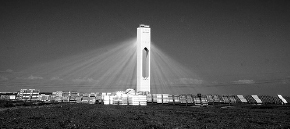Spain
031
Solúcar PS10 Power Station, Sanlúcar la Mayor, Spain
![]()
The Tower of Power
The city of Seville in southwestern Spain gets a lot of sunshine—over 320 days of nine or more hours of sunshine every year. In the peak of summer, the temperature can soar to 50°C, and the Sun shines for over 15 hours a day. The perfect weather makes Seville an ideal spot for solar power.
Drive 20 kilometers to the west of Seville and you’ll come to the small town of Sanlúcar la Mayor, where the Spanish company Abengoa has constructed two solar electricity–generating stations and is in the process of constructing more. The Sevilla PV station uses photovoltaic panels that track the Sun and provide power for about 500 homes, but if you drive out to Sanlúcar la Mayor, the first thing you’ll be struck by is a 115-meter tower rising from the landscape and apparently being sprayed with beams of white-hot gas.
The tower is at the center of a field of heliostats (mirrors that track the movement of the Sun) that focus the bright Spanish sunlight onto a receiver near the tower’s top. The reflected sunlight is so intense that water vapor and dust in the air glow white. All that’s needed to complete the scene is a maniacal James Bond villain atop the tower.
This tower is at the center of the Solúcar PS10 power station (see Figure 31-1). At the top of the tower is a solar receiver that is heated by sunlight to create saturated steam at 257°C. The steam is then used to drive a turbine that generates electricity. Make sure you’re wearing sunglasses when you look up to the top; the tower’s brilliant white glow is very intense.
The surrounding field contains 624 Sanlúcar 120 heliostats, each with a 120-square-meter surface for reflecting sunlight. Overall, the system converts about 17% of the sunlight energy into 10 megawatts of electricity. In comparison, the nearby Sevilla PV field generates about 1.2 megawatts with an efficiency of 12%.

Figure 31-1. Solúcar PS 10; courtesy of Alejandro Flores (afloresm)
Right next door to the PS10, an even larger project is under construction—the Solúcar PS20, which will generate 20 megawatts of electricity. The entire Sanlúcar la Mayor project will eventually generate 300 megawatts of electricity from towers, photovoltaics, solar troughs, and Stirling engines.
The Solnova 1 station, also currently under construction, uses parabolic troughs to focuses the Sun’s rays on a pipe containing a synthetic oil that is heated to almost 400°C. The hot oil is then used to create steam, which drives turbines to generate power. When complete, Solnova 1 will generate 50 megawatts of electricity with an efficiency of 19%.
Finally, Abengoa is planning to build a solar plant based on Stirling engines. Large parabolic mirrors will focus the Sun’s rays onto a Stirling engine at the center of each mirror. A Stirling engine is a simple closed engine that works by the repeated heating and cooling of a gas enclosed in a pair of cylinders with a pair of pistons—one piston moves when the gas is heated, the other when the gas is cooled. Between them, the pistons turn a generator to make electricity.
Practical Information
Sanlúcar la Mayor is easily reached by road from Seville, following the A-477 north to Los Ranchos de Guadimar. The Solúcar PS10 power station is 3 kilometers northwest of Los Ranchos de Guadimar, and is easily visible from the road at 37° 26′ 34.8″ N, 6° 15′ 0″ W.


